I visited her niece’s palace in Alexandria and its style wowed me with its neoclassical style as well its content as a Museum.
It was time to visit Aisha Fahmy’s Palace in Cairo after its re-inauguration as a state-owned cultural center in May 2017 following at least two decades of renovation.
Just like any place in Egypt, it has its stories and legends starring its once-owners The Fahmys.
The Aisha Fahmy palace was not initially built for once-Egypt’s-richest socialite and heiress Aisha Hanem Fahmy or Princess Aisha Fahmy.
The 2600-square-meter-Palace is located the edge of the River Nile directly in the Upscale Zamalek island was originally designed by famed Italian architect Antonio Lasciac for originally Aisha’s father Ali Pasha Fahmy in 1906.
Lasciac designed many of Egypt’s top royal palaces including Abdeen Palace after it was engulfed in fire in 1891 and Tahra Palace as well as upper-class palaces including Fatma Haidar’s Palace in Alexandria.
Reportedly King Fouad I’s chamberlain, Ali Pasha Fahmy was probably the wealthiest man in the Kingdom of Egypt and Sudan.
Legend says that he was richer than the Royal Family he had got about 5000 agricultural fedans “acres” as part of his property.
Following his death, his enormous wealth was inherited by his offspring, three daughters and only one son who decided in 1923 to renovate the palace following his marriage from a French lady earlier that year.
Originally the couple traveled to Europe for a honeymoon whereas that palace with a special Nile deck was renovated.
That son was the 23-years-old self-claimed Prince Ali Kamel Fahmy and his wife was the infamous femme fatale Marie Margeurite Ailbert.
Despite his young age, Ali Kamel Fahmy managed to make history in the West and East when he was killed by his wife in July 1923 in a crime that inspired novelists for decades.
Before the Daily Mail and the Sun go coco behind the sexual scandals of Gulf Sheikhs, the Ali Fahmy case was the scandalous case of East met West following Egypt’s independence.
It was the original mother of all xenophobic Islamophobic homophobic crime coverage of all British tabloid.
In the UK, it was West against the East: A French lady in her 30s killed her flamboyant rich Egyptian bisexual husband for his cruel abnormal behavior in self-defense.
Back in Egypt, it was sensational affair but it was East against West: The French gold digger who killed the spoiled rich Egyptian young man because he busted her with another man in their Savoy suite in that stormy night.
The trial was a true racist farce that ended up in acquitting Margeurite Ailbert on the basis of self-defense.
Boldly, Ailbert wanted her share in Aly Kamel Fahmy’s wealth but she could no penny as she lost her lawsuits against the Fahmys in front of the Egyptian court.
Amazingly after 90 years, we found a book saying that Royal family and the British government interfered in the trial to save Prince Edward VII from scandal as Marguerite, turned to be his first love and she got some juicy letters.
Back to our palace, following his tragic death Aly Kamel’s sister Aisha Fahmy acquired her sisters’ shares in the palace “ they inherited their brother’s wealth including the palace” in May 1924 for LE 72,000
The Palace underwent another round of renovations to suit the exquisite taste of Aisha Fahmy who became Egypt’s wealthiest woman during then in 1932.
Interestingly Fahmy moved into the Palace with her husband Youssef Wahby Bey, the dean of Egyptian theatre and they lived there till their divorce two years later in an ugly divorce that made headlines too.
It is worth to mention Wahby made a film inspired by Ali Kamel Fahmy’s tragedy in what is believed to be Egypt’s first sound film “Awald Al-Zawat” or “The rich kids”.
Aisha Fahmy passed away in 1962 and so the Palace was inherited by her sisters and their siblings.
Two years later in 1964, the palace was nationalized or rather confiscated by the state.
It was decided then to turn it into hotel operated and owned by The Egyptian Corporation for Hotels.
In 1971, the Fahmys sued the state demanding either they got back the palace or the state would pay a LE 30-million compensation whereas the Egyptian government estimated it by LE 64,000 then reportedly.
As far as I remember the State and the heirs reached a financial settlement.
Then in 1986 another presidential decree by ex-President Mubarak assigning Fatimah Haider’s Palace in Alexandria to become the Mohamed Ali Royal Family Jewels Museum.
Once again the palace returned back to the museum of culture.
Then it was declared that the palace would turn in to a cultural centre.
Restoration works started officially in 2005 and I do not understand why the renovations took too long.
In May 2017, the Palace of Aisha Fahmy re-emerged once again to life in Cairo but this time as Al Gazeera Centre of arts in Zamalek.
A center of arts, the Palace hosts every couple of months an exhibit of rare objects from Egypt’s Museums starting with special textiles throughout time exhibit.
I went to a special exhibit called “Features of an era” dedicated to the Mohamed Ali Royal Family in March. The exhibit showed for the first portraits and statues as well few belongings to the royal family that ruled Egypt from 1805 to 1952.
That exhibit needs another separate post.
Now from outside, that red neoclassical palace does not have a catchy unique exterior like for instance the Fatimah Haider palace and its Eastern and Western branches or its neighbor gothic palace.
But it is all about inside after all. Legend says each room in the palace has a different style the other rooms
Just like Fatimah Haider Palace, the stained glass catch your eyes starting with the roof itself.
Here is a closer look at the stained glass ceiling, I think that chandelier is not an original part of the palace.
Then you got the staircases and its stained glass depicting those romantic renaissance scenes.
I mean they look amazing and beautiful. No wonder they became an attraction for photographers and Selfie takers alike.
Girls used to snap photos while I was taking photos for that beautiful part.
I tried a snap several photos for them but due to a technical error, I caused it turned to be horrible photos as you can see.
That what I could salvage from those moments
They are located on the backside of the Palace, you can see them from outside in the night if the Palace’s lights are on.
It is the only way to get to the second floor for visitors, you can’t ignore its beauty.
Ironically Ali Pasha Fahmy is overshadowed by his children especially by his own son in the saddest way.
In 2019, I can't find an accurate historical record about the man because there were at least two other Ali Pasha Fahmys who also played an important role in Pre-1952 Egypt.
In other rooms on the floor, you have pay to its details because you focus more on the exhibit's items and miss details like those paintings in the wall panels.
If you zoom in the photo featuring that neoclassical romantic scene, you can see them above some wooden golden depicting of Greek deity "Triton” if I am not mistaken.
Now I think Aisha Fahmy was among the very few Non-Royal Family members who had her own Dressing room in Egypt.
Remember we are speaking about the richest woman in Egypt pre-1952 so it is not a surprise to see that old dressing room.
Now I apologize because the quality of the photos are not great there because it got very poor lighting just like any Egyptian museum as it seems.
It was time to visit Aisha Fahmy’s Palace in Cairo after its re-inauguration as a state-owned cultural center in May 2017 following at least two decades of renovation.
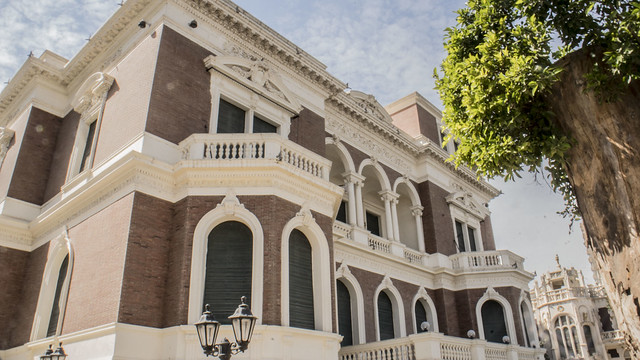 |
| Aisha Fahmy Palace in Zamalek |
The Aisha Fahmy palace was not initially built for once-Egypt’s-richest socialite and heiress Aisha Hanem Fahmy or Princess Aisha Fahmy.
The 2600-square-meter-Palace is located the edge of the River Nile directly in the Upscale Zamalek island was originally designed by famed Italian architect Antonio Lasciac for originally Aisha’s father Ali Pasha Fahmy in 1906.
 |
| The main entrance to the palace |
Reportedly King Fouad I’s chamberlain, Ali Pasha Fahmy was probably the wealthiest man in the Kingdom of Egypt and Sudan.
Legend says that he was richer than the Royal Family he had got about 5000 agricultural fedans “acres” as part of his property.
Following his death, his enormous wealth was inherited by his offspring, three daughters and only one son who decided in 1923 to renovate the palace following his marriage from a French lady earlier that year.
Originally the couple traveled to Europe for a honeymoon whereas that palace with a special Nile deck was renovated.
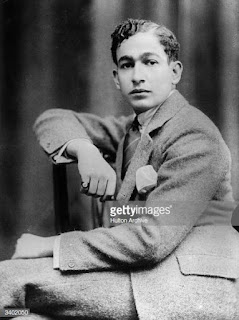 |
| The self-claimed Prince Ali Kamel Fahmy Getty Images |
Despite his young age, Ali Kamel Fahmy managed to make history in the West and East when he was killed by his wife in July 1923 in a crime that inspired novelists for decades.
Before the Daily Mail and the Sun go coco behind the sexual scandals of Gulf Sheikhs, the Ali Fahmy case was the scandalous case of East met West following Egypt’s independence.
It was the original mother of all xenophobic Islamophobic homophobic crime coverage of all British tabloid.
In the UK, it was West against the East: A French lady in her 30s killed her flamboyant rich Egyptian bisexual husband for his cruel abnormal behavior in self-defense.
Back in Egypt, it was sensational affair but it was East against West: The French gold digger who killed the spoiled rich Egyptian young man because he busted her with another man in their Savoy suite in that stormy night.
The trial was a true racist farce that ended up in acquitting Margeurite Ailbert on the basis of self-defense.
Boldly, Ailbert wanted her share in Aly Kamel Fahmy’s wealth but she could no penny as she lost her lawsuits against the Fahmys in front of the Egyptian court.
Amazingly after 90 years, we found a book saying that Royal family and the British government interfered in the trial to save Prince Edward VII from scandal as Marguerite, turned to be his first love and she got some juicy letters.
Back to our palace, following his tragic death Aly Kamel’s sister Aisha Fahmy acquired her sisters’ shares in the palace “ they inherited their brother’s wealth including the palace” in May 1924 for LE 72,000
The Palace underwent another round of renovations to suit the exquisite taste of Aisha Fahmy who became Egypt’s wealthiest woman during then in 1932.
 |
| The only photo available online for Aisha Fahmy "far-left" of Egypt's legendary PM Mostafa El-Nahas and his wife Zeinab El-Waikal on the right |
 |
| The palace's exterior |
Aisha Fahmy passed away in 1962 and so the Palace was inherited by her sisters and their siblings.
Two years later in 1964, the palace was nationalized or rather confiscated by the state.
It was decided then to turn it into hotel operated and owned by The Egyptian Corporation for Hotels.
In 1971, the Fahmys sued the state demanding either they got back the palace or the state would pay a LE 30-million compensation whereas the Egyptian government estimated it by LE 64,000 then reportedly.
As far as I remember the State and the heirs reached a financial settlement.
 |
| The backside of the palace |
Once again the palace returned back to the museum of culture.
Then it was declared that the palace would turn in to a cultural centre.
Restoration works started officially in 2005 and I do not understand why the renovations took too long.
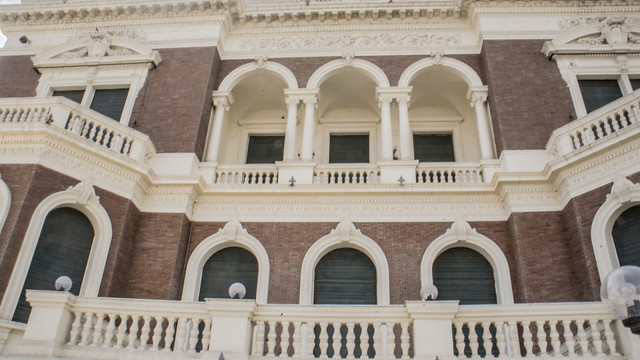 |
| That side of the palace was on the Nile river's side, the beside view of all |
A center of arts, the Palace hosts every couple of months an exhibit of rare objects from Egypt’s Museums starting with special textiles throughout time exhibit.
I went to a special exhibit called “Features of an era” dedicated to the Mohamed Ali Royal Family in March. The exhibit showed for the first portraits and statues as well few belongings to the royal family that ruled Egypt from 1805 to 1952.
That exhibit needs another separate post.
Now from outside, that red neoclassical palace does not have a catchy unique exterior like for instance the Fatimah Haider palace and its Eastern and Western branches or its neighbor gothic palace.
 |
| Zoom in to see that gothic palace on the right |
But it is all about inside after all. Legend says each room in the palace has a different style the other rooms
Just like Fatimah Haider Palace, the stained glass catch your eyes starting with the roof itself.
 |
| The stained glass ceiling |
 |
| The stained glass ceiling from the second floor |
 |
| The stained glass overlooking the staircase |
 |
| The stained glass overlooking the staircase |
I tried a snap several photos for them but due to a technical error, I caused it turned to be horrible photos as you can see.
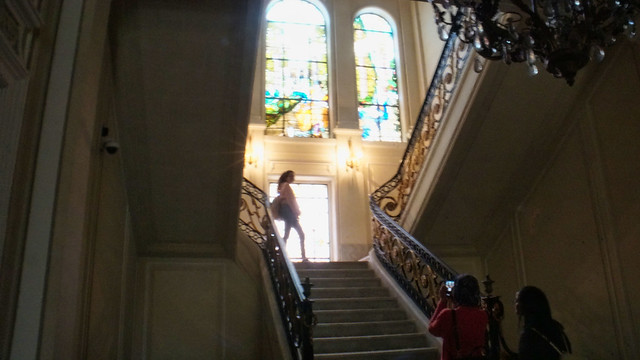 |
| Capturing a moment in a selfie |
 |
| The stained glass overlooking the staircase |
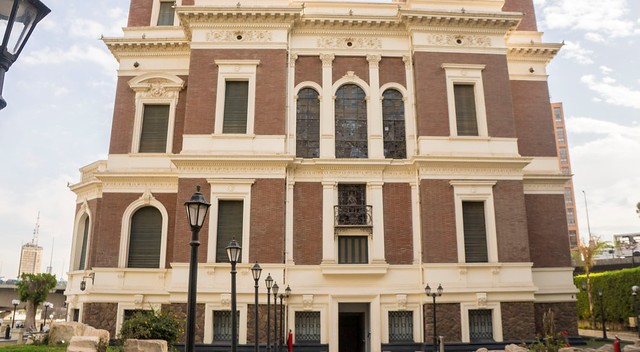 |
| The backside of the palace and its stained glass only can be seen at night if it was lit |
 |
| The stained glass overlooking the staircase |
The main hall leads to several rooms.
They were mostly hosting paintings and statues of the Mohamed Ali Royal Family as part of the exhibit except for one room: The billiard room.
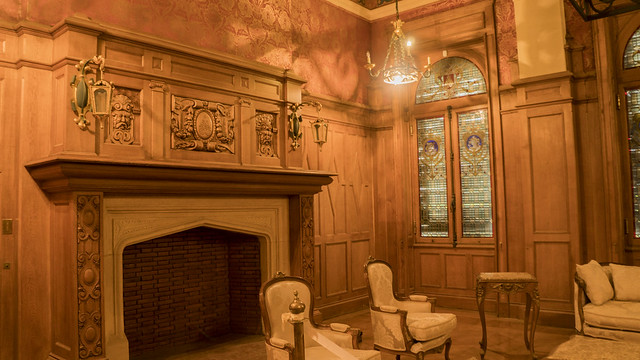 |
| The once billiard room is a living room now |
The-once-billiard-room with a wooden fireplace is now a living room.
Needless to say, this modest living room is not from the original Aisha Furniture.
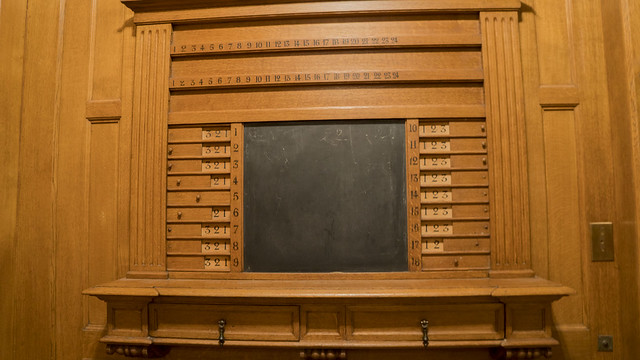 |
| The billiard scoreboard |
I do not know but I felt that the vibes of the miserable Aly Kamel Fahmy were there and that he used to play billiard there.
The billiard wooden scoreboard is still there to remind us of the original identity of that room.
There is the only room in the house that still carries the insignia of Ali Pasha Fahmy, the first owner of the place.
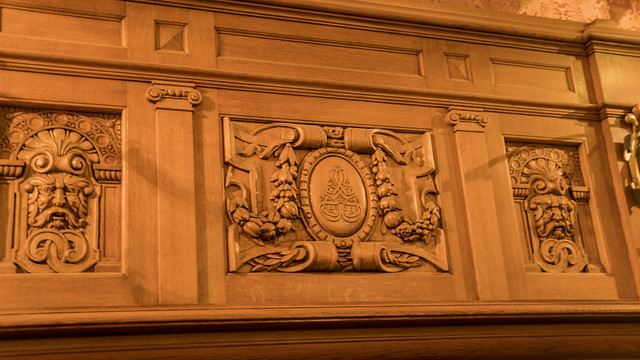 |
| Zoom in and you will find the name of Ali Fahmy written in Arabic in that insignia |
In 2019, I can't find an accurate historical record about the man because there were at least two other Ali Pasha Fahmys who also played an important role in Pre-1952 Egypt.
In other rooms on the floor, you have pay to its details because you focus more on the exhibit's items and miss details like those paintings in the wall panels.
 |
| That traditional neoclassical scene of a naked lady with a bunch of child angels |
All those paintings were hand-painted by Italian and French artists according to my knowledge.
 |
| The view of the main hall in the palace from the staircase |
Now to the rooms especially on the second floor, one thing for sure the Fahmys loved the Western-style especially the Neoclassical style.
There are several neoclassical romantic paintings in wall panels in several rooms.
 |
| Triton is above those girls holding ribbons !! |
Now I think Aisha Fahmy was among the very few Non-Royal Family members who had her own Dressing room in Egypt.
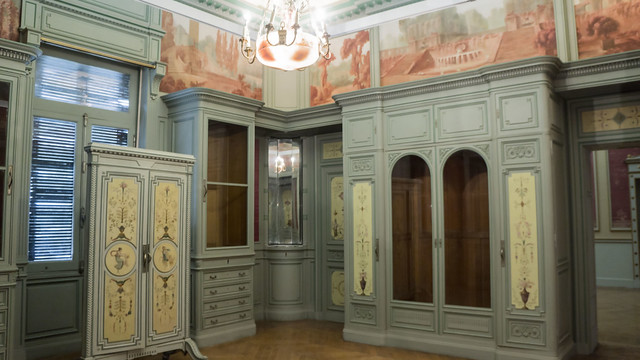 |
| Pay attention to the paintings in the panels above the wardrobes ya people. |
 |
| Just imagine what was in those wardrobes |
Aside from the closets and their beautiful decoupage paintings, there are small details in the room that make look up above.
 |
| You can use the paintings above the wardrobes |
The hand paintings decanting scenes from the Italian countryside as well as those small light fixtures.
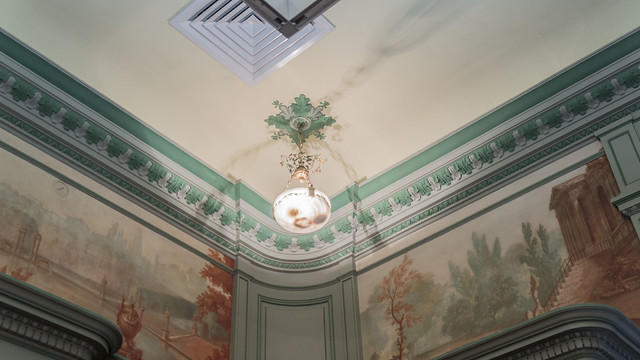 |
| Pay attention to the small details |
Besides the French style dressing room, there is a very beautiful Japanese room on the floor.
 |
| This room was one of the little nice surprises in the palace |
Yes, a Japanese room not a Chinese room because some people mix between them.
 |
| One side of the side whose walls are made of painted woods |
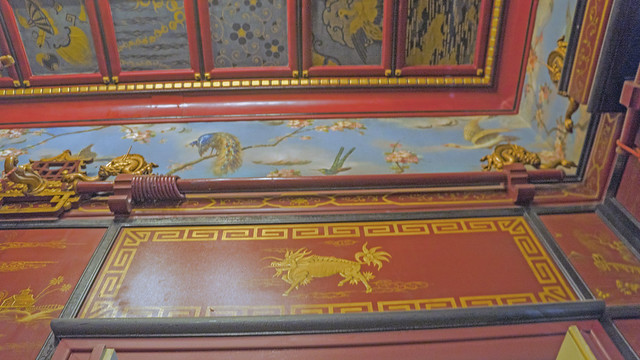 |
| The tiny details and paintings are more than impressive in this poorly lit room |
According to what it is known that the Japanese room was a gift from the Japanese embassy to Aisha Fahmy.
Aside from the beautiful Japanese wooden decorations, there are two golden-painted wooden Buddha statues.
 |
| One of the Buddha statues in the room |
It is a beautiful room and I wonder how Aisha Fahmy was using it.
You can see it here in a very bad video.
You can see it here in a very bad video.
Ironically when you think about East and West met in that room in that complete-neoclassical western palace.
There are 30 rooms in the palace including the rooms in the 1000-square-meter basement which originally was used for kitchen, laundry room and servants quarters according to my knowledge.
This palace is just a little reminder of the huge gap between the rich and poor in Egypt whether before 1952 or afterward.
 |
| Upstairs on the second floor during the "Features of an era" exhibited continued A teaser of the paintings I photographed, the portrait of King Fouad I |
No one can deny this and those palaces are proof on that.
Needless to say, social justice was not achieved by Nasser’s policies as we saw. Nationalization was not the correct way to bring balance in the society. I see taxation if adopted correctly especially progressive taxation.
Anyhow looking back to Aisha Fahmy and her palace.
I think the late socialite would approve that her palace turned eventually into a Cultural center carrying her name forever.
Yes, it is called “Al-Gazira Cultural Centre” but it is known more as Aisha Fahmy Cultural center.
No comments:
Post a Comment
Thank You for your comment
Please keep it civilized here, racist and hateful comments are not accepted
The Comments in this blog with exclusion of the blog's owner does not represent the views of the blog's owner.